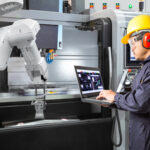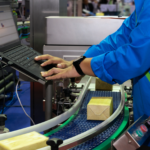Edge computing in industrial automation refers to systems with distributed electronics that locally collect, store, analyze, and act upon with unrivaled speed. A related industrial-network structure brings cloud-computing capabilities down into the furthest reaches of the factory-floor via nodes and networks. Called fog computing, this distributed intelligence as well as data processing out at a design’s most distal device locations (before data heads onward) have been available for some time. But devices with more computing power than in the past now allow unprecedented local preprocessing and predictive-maintenance functions … plus holistic views of processes for iterative design optimization.
Let’s now consider the taxonomy of edge computing to avoid confusion. After all, the definition of edge computing references data computation at a network’s extremities … but the definition of edge or extremity is relative. The actuators, sensors, and other edge devices so fundamental to edge computing are supported by gateways and controllers with dedicated connectivity functions. These sensing and actuating components are located near machines’ end effectors and active axis areas, which is why they are called edge devices — and in many cases (though not always) they use their logic resources to process speed, position, volume, throughput, and other data before sending it onward to controls, the cloud, or onsite servers and other IT infrastructures. In contrast, many industrial-component suppliers use the term edge computing to primarily refer to the aforementioned gateways and controllers involved in data collection, analysis, and factory-floor feedback in realtime. In this context, the edge is that of the factory at its border with MES, ERP, and higher-level enterprise systems.

Some supplier ecosystems incorporate logistics, IT systems and security, networking, and cloud-connectivity solutions. Separate factories and their components — including semi-finished and finished workpieces and other physical objects as well as various pieces of data — are part of a larger network. Such comprehensive networking and data management is spurring new business operations based on big data and universally applicable cloud applications.

IIoT unification with HMIs lets engineers integrate smart-factory equipment into superimposed SCADA, MES, ERP, and cloud services … and blur boundaries between these systems for information technology and operational technology (IT/OT) convergence. That helps operations simplify system configurations, operational adjustments, and managerial actions — as well as optimize maintenance schedules. IIoT HMI technologies also support freer information exchanges between suppliers and end users.
Digital-transformation (DX) initiatives necessitate massive increases in the transmission of plant-floor data, and edge computing bridges IT and OT to handle this data while supporting event-driven architectures. After all, edge computing (thanks to its local processing of information) is inherently fast — in many cases, supporting realtime machine responses to local data analysis. Edge computing can also make installations more energy efficient as well as operationally efficient, as it streamlines machine-to-machine communications with parameters defined in standardized formats for multi-machine usability. What’s more, realtime tracking of energy waste allows quick corrective action.
Common hardware for edge computing
Some component suppliers have pushed technology to bring more logic, computing, and analytics to the device level — especially in the form of controllers and drives for decentralized control. These components support modular machine designs for scalability as well as setup and operation via one software ecosystem. Other connected examples are specific to applications — such as handheld pneumatically and motor-driven tools (complete with integrated control logic) for fastening. Elsewhere, an assembly arrangement enabled by edge computing might use an adaptive-resistance weld controller to manage weld growth in realtime with onboard logic for repeatable spot quality … even on various combinations of sheet thicknesses and materials.

HMI capabilities constituting IIoT functions include realtime supervision as well as advanced event logging and triggering, diagnostics, and additional enterprise-level monitoring.
But even legacy systems without such IIoT tools and end effectors can benefit from new modes of connectivity. Here and in new installations, the role of gateways for edge computing is central — especially when smarter use of feedback for distributed control is advantageous … and disparate systems need unification. Some gateways and HMIs accept setup via supplier software that in turn supports multiple programming languages and communication drivers. Many gateways also run complementary supplier software for remote access to automated equipment (via mobile devices) about machine health and other parameters. Such gateways execute many tasks typically associated with HMIs — such as running macros for control and data-transfer functions; concurrent networking of device arrays; handling and logging alarms; triggering data storage; and interfacing with cloud services.

Traditional factory automation (and the machine automation that integrates into it) has a hierarchal system architecture. But cloud and fog computing (data processing on the shop floor) are on the rise, and that’s blurred the lines demarcating component functions. Edge-level solutions with high computing power have accelerated this trend.
For older brownfield equipment upgrades, IoT gateways and software can provide single-point data collection and preprocessing before data travels to a higher processing system. First-generation IoT gateways have over the last decade advanced considerably. Here, software can complement newer gateway hardware with edge-based visualization and shop-floor management for realtime decision making and collaboration. In addition, platform-neutral connectivity software (in some cases based on the Java Runtime Environment) allows additional edge-based flexibility for rapid data exchange.

Industry uses a wide array of terms to group and define the tasks associated with manufacturing management. One term widely used by both discrete as well as process (batch) automation organizations is manufacturing execution systems or MESs. This refers to the intermediate automation systems with which many connectivity components are primarily associated. Other partially equivalent terms include manufacturing operations management or MOM (more heavily oriented to discrete control) and production process management or PPM.
Yet other solutions combine cloud gateways with cloud-based (and configurable) web services. These integrate smart-factory equipment into superimposed SCADA, manufacturing execution systems (MES), and ERP systems as well as the cloud. Besides the optimization of maintenance schedules, such solutions also support the exchange of information between suppliers and end users.
Leading IoT gateways can adapt to all common devices and enterprise systems on the market — and even to multiple PLCs at once. Additional applications include contextualized visualization, the management of consumable materials, and cellular connectivity to remote machines. OEMs in the packaging and printing industries benefit most from the insights gained through this production-data access because they can use analysis of it to develop features on their next-generation machines. However, some make a clear distinction between edge device and gateway functions … read about the nuances here: Edge computing and gateways proliferate for industrial machinery.
You may also like:
Filed Under: Factory automation, DIGITAL TRANSFORMATION (DX)









